Horse Discovery: Breeds
Horse Discovery: Breeds by Type
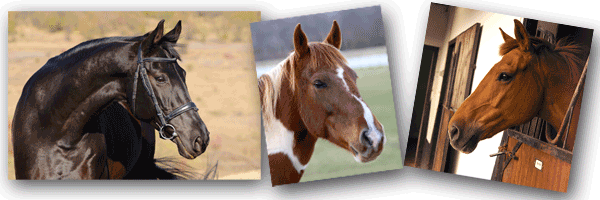
Stock

- Type: Stock
- Origin: North America
- Important Traits: Short distance speed, docile temperament, athletic and versatile.
- Uses: Short Distance Racing, rodeos, Western competitions, dressage and jumping, ranch work, etc .
- Size: 14.2- 17 Hands
Color Pattern: Recognized colors include: bay, brown, black, sorrel, chestnut, dun, red dun, grulla, buckskin, palomino, gray, red roan, blue roan, bay roan, cremello, and perlino. The most common color is sorrel. American Quarter Horse promotes solid colored horses, but occasionally they can produce offspring with overo paint characteristics. These markings are undesirable traits.
The American Quarter Horse is named for its speed over a short distance (a quarter mile). The first horses that resembled the current Quarter Horse were brought to the United States in 1620. The English Thoroughbred and the colonial Short Horse had the most significant influences on the breeding of the Quarter Horse. Other horses in the pedigree include Spanish Barbs, Rhode Island racing stock, Andalusians, Mustangs, Colonial mid-Atlantic Quarter Pacers, and horses of the Chickasaw Indians. As settlers moved west, the Quarter Horse traveled with them, pulling wagons, buggies, and plows. It was discovered that these horses had exceptional "cow sense" which made them perfectly suited for ranch work. These willing horses are also used as pleasure horses for all ages. Today the breed has developed different types of horses bloodlines according to their success in shows and competitions. They include cutting, reining, halter, running, ranch and pleasure horses.
The American Quarter Horse face includes features such as a short, fine head, a straight profile, small, alert ears and wide set eyes. They have an arched, muscular neck and well defined withers. The American Quarter Horse has a wide, deep chest and long, muscular, and well sloped shoulder. The forearms, gaskins, and thighs are also muscular. Legs have clean joints and are well formed. Some American Quarter Horses have feet that are small in proportion to their body.

- Type: Stock
- Origin: Spain
- Uses: Western competitions, show, ranch work, dressage, rodeos .
- Important Traits: Striped hooves, bold coat-color patterns, intelligence, speed and disposition
- Size: 14.2- 16 Hands
- Color Pattern: Recognized Appaloosa color patterns include snowflake, marble, frost, spotted blanket, white blanket, and leopard. The horse may also be a solid color. Horses must show white sclera (white around the eyes), mottled skin (specking of pigmented and non-pigmented skin), and have black and white striped hooves.
Spotted Horses, like the Appaloosa, can be found in ancient Chinese and Mediterranean art and in Cave paintings in France. During the 1500's these Mediterranean horses were introduced to Mexico by the Spanish. By 1700, they were found in the Pacific Northwest in the Nez Perce tribe. As settlers came into the area, they called the horse 'A Palouse Horse' because of the Northern Idaho river, the Palouse River. The name evolved to 'Palousey' and 'A Palousey' before becoming the Appaloosa. The Appaloosa was named the state horse in Idaho in 1975. They can also be found across the world. These stock type horses are reliable as family horses.
The Appaloosa features a small but well shaped head with pointed ears and a straight profile. White sclera can be seen in the large eyes. The mane and tail on an Appaloosa may be sparse, although this is not a desirable trait. The neck is long and muscular and the withers are only moderately pronounced. The Appaloosa has a deep chest, a short back, and long and sloping shoulders. Legs have good bone structure, are muscular and are solid. Vertical light or dark stripes are found on the hooves. The skin is mottled on the nose, lips and genitals.
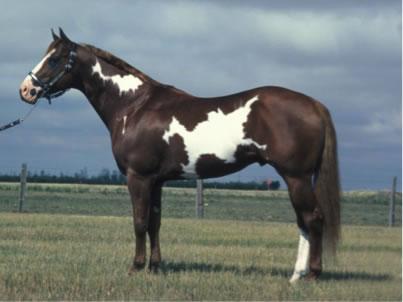
- Type: Stock
- Origin: Spain, North America
- Uses: Showing, western competitions, ranch work, trail rides, rodeos, etc.
- Important Traits: Striking appearance, athletic, gentle temperament, willing disposition
- Size: 14.2 to 16.2 Hands
- Color Pattern: There are three main color patterns, tobiano, tovero and overo. The tobiano has white markings that are regular and distinct, that extends across the dorsal midline, often with four white legs. The head markings are similar to those of a solid horse. The overo has at least one dark leg, rarely any white extending across the dorsal midline. The markings are scattered and irregular. The base color may be any color. The tovero is a mix of the tobiano and the overo. Spanish explorer, Hernando Cortes sailed to the New World in hopes to find fortune in 1519. He brought horses, thought to be the Paint horse along with him. In the 1800's these spotted horses could be found freely in the west. They were a favorite by Indians because of their flashy colors and spots.
These horses were called a variety of names including pinto, paint, skewbald, and piebald until 1960's when the American Paint Horse Association was founded. Today, the American Paint Horse is the 5th largest breed in the world and growing. The association is regulated by restricted bloodlines. The only outcrosses allowed are to Quarter Horses and Thoroughbreds. Gaited breeds, draft breeds, or pony breeds are not recognized. The American Paint Horse is a stock horse with a straight profile, average size ears, and large eyes. The horse should have a muscular neck, short, strong back, sloped shoulder, and well muscled, sold legs. Joints and tendons are also strong in the American Paint Horse. The most distinctive trait is the color patterns found on this type of horse.
Racing


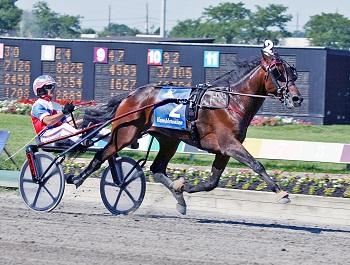
Type: Light Breed
Origin: New York
Uses: Harness Racing (trotting or pacing), pleasure driving or riding
Important Traits: Speed, tolerant, ground-covering gait
Size: 15 to 16 Hands
Color Pattern: Most common colors are bay, brown, and black. The horse may have minimal white on lower legs and the face. Typically have a long and thick mane and tail.
The beginnings of the Standardbred date back about 200 years, and have the Thoroughbred as ancestors. The name of the horse developed from the standard that the horse must meet for a mile distance in order to be registered as part of this new breed. Harness racing continues to use a mile as the standard distance. This harness racing brought horse racing to the common man in 1806, when the first races kept records. Today, Standardbred’s are bred almost solely for harness racing. Because the important factor is speed, conformation is less important in this breed.
The Standardbred has a slightly convex or straight profile. The head is less refined than the Thoroughbred’s with nostrils that are capable of considerable extension, to take in more air at racing speed. The neck is straighter and shorted than the Thoroughbred’s. The body is more muscular and longer than the Thoroughbred’s. The extra slope in the quarters and then length of the muscles in the thighs and quarters give the horse its great movement at racing speed.
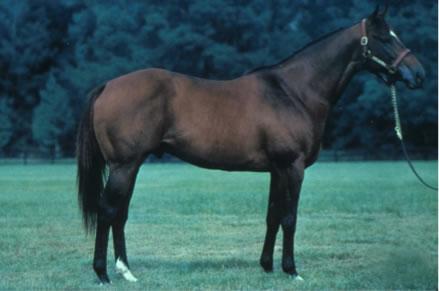
- Type: Light Breed
- Origin: England
- Uses: Racing, Polo, Foxhunting, showing, dressage, jumping, eventing
- Important Traits: Speed Size: 15 to 17 Hands Color Pattern: Colors are bay, black, chestnut, or gray. It is common for white marking on lower legs and the face.
Horses have been racing since they were domesticated thousands of years ago. The Thoroughbred has evolved over time to become one of the best racing breeds. English bred racing horses arrived in the U.S. between 1730 and 1770. Thoroughbred racing was known as the sport of the rich although all people enjoy watching it today. Thoroughbreds in the US have about 36,000 new foals each year, mainly with the intent to race. They are also used in polo, hunting, jumping, and upper-level dressage horses.
The Thoroughbred has a straight profile with a small head, large eyes, flared nostrils and active, proportioned ears. The neck is either straight or arched and is long. The chest is wide and high and the shoulders are muscular and sloped. The back is long and the withers are prominent. The tail is high set and the legs are large and long, with muscular forearms, and clean joints. Hooves are small in proportion to the body size.
Saddle and Pleasure

- Type: Saddle
- Origin: Kentucky, Eastern United States
- Uses: Show, driving, trail and pleasure riding
- Important Traits: Smooth gait, charisma, dependability, stamina, animation
- Size: 15.2- 17 Hands
- Color Pattern: Nearly all colors, including bay, brown, black, chestnut, roan, and gray. There are no color restrictions in the breed registry.
The American Saddlebred was founded in Kentucky, first being called the Kentucky Saddler and then the American Saddler. Many light breeds, including Morgans and the Canadian Pacer contributed to the development of the American Saddlebred, including a Narragansett Pacer. This horse breed was known for their amble, a gait just out of true pace. Thoroughbreds added speed, refinement, and elegance to the breed, including the famous Saddlebred Denmark. This horse is featured in so many pedigrees that he was designated the single foundation sire of the American Saddlebred. American Saddlebreds can be shown both in riding and driving divisions. They are also used as trail and pleasure riding horses.
American Saddlebred horses have small, alert ears, a finely chiseled head and large eyes. They feature an arched, long neck, wide chest and a short but strong back and hindquarters. The croup is high and flat and the tail is often long. The American Saddlebred has naturally well-formed feet and good joints, making the horse structurally sound and suitable for ranch work, jumping, and dressage.

- Type: Pleasure
- Origin: Middle East
- Uses: Trail riding, endurance, English and Western pleasure show, cutting and reining, jumping and dressage, etc.
- Important Traits: High intelligence and trainability, spirited disposition, and stamina
- Size: 14 to 15.3 Hands
- Color Pattern: Bay, gray, black, chestnut, and roan. Arabian's have black skin. White markings can be on face and lower legs.
The origin of the Arabian horse continues to be a debate among experts. We do know that the horse was domesticated around 1500 B.C. Three Arabian stallions were imported to Europe between 1683 and 1730, starting a revolution in horse breeding. These three stallions started the Thoroughbred breed. The first Arabian horse was brought to the US in 1725 by Nathan Harrison of Virginia. The Arabian Horse Association Registry was founded in 1908. The Arabian Horse is unique because it is not the result of selective breeding and it is the ancestor for the development of many other breeds, such as the Thoroughbred and Quarter Horse. Today, California and Arizona have the most registered Arabs. They can be found in every state and nearly every country in the world. Arabians have a distinctive ‘dished’ face, small ears and prominent ears and nostrils. Arabians are known as great endurance horses, despite their small stature.
Arabian horses have a straight or dished profile, ranging from slight to extreme. Their small face has large eyes, a wide forehead, and a small muzzle. The small ears should curve at the top. The long and arched neck should be narrow at the throatlatch and wide at the base. Arabian horses have a short back, long and pronounced withers, a high flat croup and a high set tail. Shoulders are long and sloping and the deep chest is muscular and broad. Legs have broad, strong joints and are muscular. The hooves should be wide at the feel and tough. The Arabian coat should be silky and fine.

- Type: Light Breed
- Origin: Springfield, Massachusetts
- Uses: Showing, dressage, western pleasure, etc
- Important Traits: Versatility, Staying Power, Solid Gait
- Size: 14.1- 15.2 Hands
- Color Pattern: Typically chestnut, bay or brown, may also be black, gray, palomino, creme, dun, or buckskin.
In 1798, the first Morgan Horse was born from an Arabian mare and a Thoroughbred stallion. The horse was named Justin Morgan, after his owner, and became known throughout New England for his abilities in pulling, trotting, racing, and general riding. Morgan's were favored during the Civil War by soldiers because of their ability to remain sensible while under fire. Today Morgan's are sturdy with solid gaits with a refined neck and head that gives them an air of elegance. They have contributed to the development of the Standardbred, American Quarter Horse, American Saddlebred, and Tennessee Walking Horse.
Morgans are known for their alert expressions. Their heads have wide-set, large eyes and attractive, small ears. The neck is muscular and arched. The withers should be prominent with the distance between them and the floor of the chest greater than the distance between the ground and the floor of the chest. The shoulders are sloping and long and the ribs are angled toward the rear and well sprung. The legs have well defined tendons and clean joints although they are not long. The Morgan’s feet are of excellent quality.
Sport Horse
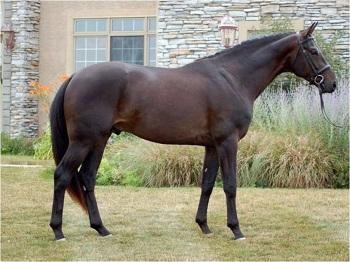
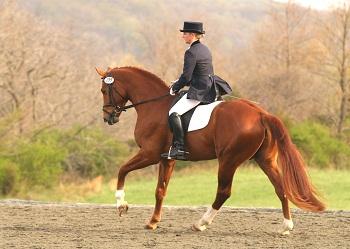
- Type: Light Breed
- Origin: Germany
- Uses: Show and field hunters, show jumping, dressage, combined driving, eventing.
- Important Traits: Athletic Ability, Light and Elastic Gaits
- Size: 16- 17.2 Hands
- Color Pattern: Colors include chestnut, bay, black, and brown. Grays are not favored in Germany but are allowed. White markings on face and lower legs are common.
In 1653, coach horses were bred for the nobles of the house of Hanover. They were known as excellent carriage horses because of their smooth gait, ability as a driving horse, and for their cream color. The Hanoverian became known throughout Europe, even becoming the horses of the British royal family. In 1714, Ludwig George became King of England and made the Hanoverian an official breed. In the past, Hanoverians were bred for the needs of the army and of agriculture. Since the end of World War II, the horses have been bred to become a versatile performance horse. The American Hanoverian Society was founded in 1978. To be accepted into the Society, horses must first undergo a selection process that includes inspection, testing and an approval process that is similar to the process in Germany.
Hanoverians are athletic horses. They compete in dressage, show jumping, and combined driving on many Olympic teams. They are often the top horses at hunter shows. The Hanoverian has a straight profile and a plain head. The neck is muscular and the shoulders are powerful and sloping. The Hanoverian has very powerful hindquarters and good feet.


- Type: Light Breed, Sport type, Warmblood
- Origin: Germany
- Uses: Show and field hunters, show jumping, dressage, combined driving, eventing
- Important Traits: Athletic Ability, light and elastic gaits, highly versatile.
- Size: 16- 17 Hands
- Color Pattern: Solid colors, include chestnut, bay, black, gray and brown.
- Description: The Holsteiner has a straight profile. Muscular and powerful.
The Holstein is a German Warmblood breed that takes its name from the Schleswig-Holstein area where it originated, and is generally believed to have developed through the 13th century. It is likely that they are descended from a mix of German, Spanish, and oriental blood, and that during the Middle Ages, the Holsteiner was a heavy but elegant warhorse, as well as being used for agricultural purposes. They were frequently used both by the cavalry and as a gun horse for pulling the heavy artillery. During the 17th century they became more popular as carriage horses, although they were still quite coarse in appearance, with a heavy frame and a short stride. One famous Holsteiner of the 17th century was the gray stallion Mignon, who became the founder of the cream horses, which were prized by Electors of Hanover, and were used at the British Royal Mews until 1920.
During the 19th century, there was an infusion of Thoroughbred blood to improve the Holsteiner's conformation, refinement, and speed, and also of Yorkshire Coach Horse blood, which is credited with supplying the Holsteiner's excellent temperament and wide action. They have a superb temperament, which makes them very easy to get along with. They are also highly versatile, being talented at both dressage and jumping, which makes them a popular competition horse worldwide.
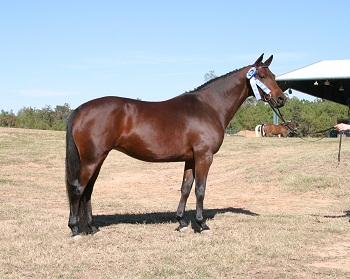
- Type: Light Breed
- Origin: East Prussia
- Uses: Dressage, jumping and eventing
- Important Traits: Strong joints and muscle, ground-covering gaits
- Size: 16 to 17 Hands, and above
- Color Pattern: Can be any solid color with the most popular being chestnut. May also be bay, brown, black, and gray. Minimal white markings on face and lower legs are common.
In the 1800’s, this originally stocky horse was bred to be a better endurance horse for ridding during wartime and working on farms at other times. Thoroughbred and Arabian horses were used to enhance these characteristics. War times were hard on the Trakehner. Their population dropped in half during World War I. During World War II, about eight hundred of the best horses were shipped to the Soviet Union, where many lost their documentation, and were held for nearly a year. The Trakehners were first brought to Canada in 1957 and to the U.S. in 1963. Today the Trakehner is noticed for its elegant way of moving, its powerful hindquarters, and its achievement in jumping and dressage. The American Trakehner Association requires a horse to be inspected before being registered.
The Trakehner is a tall horse although the legs are shorter than that of most Thoroughbreds. The head resembles its Arabian heritage. The eyes are large and the forehead is wide. The neck is graceful and long and the withers are prominent. The Trakehner has a deep chest and muscular, sloped shoulders. The tail is high set and the croup is slightly sloped. The legs have clean joints, defined tendons, and are muscular. The hooves are solid.
Gaited Horse
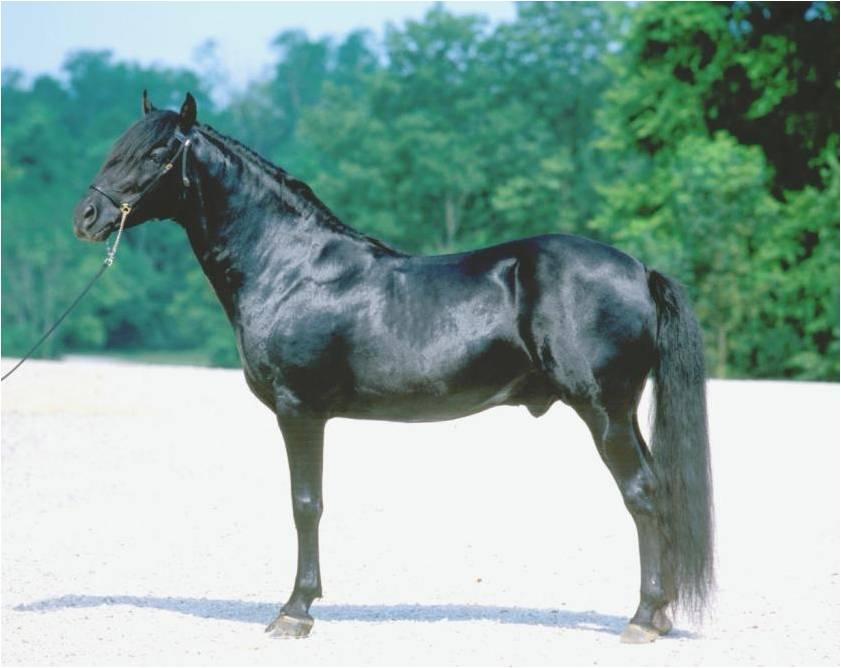
- Type: Light Breed
- Origin: Eastern Kentucky
- Uses: Family Horse, Trail Riding, Small-scale Farming
- Important Traits: Ability to carry rider safely over rough ground, Gaited Horses known for sure-footedness
- Size: 11-15.2 Hands
- Color Pattern: May be any solid color with white on the lower legs or face. White body spots, above the knee or the hocks is permitted by the Kentucky Mountain Saddle Horse Association, which has a branch called Spotted Mountain Horse Association.
The beginnings of the Kentucky Mountain Saddle Horse are mostly unknown because few written records were kept. Tennessee Walkers are one of the ancestors for the breed, and the breed probably started 160 to 200 year ago. The horses were bred to work on small farms on rough land. Times were often tough so the horses had to be self sufficient. Although records were often not in writing, the farmers knew the qualities they wanted and produced a horse that has met their needs for centuries. Mountain Horses have three gaits, a trail walk, a single foot, and a canter. They are gentle enough for everyone, including children to ride.
The Kentucky Mountain Saddle Horse are small- to medium- size athletic horses. They have a flat profile that is not dished or Roman. Kentucky Mountain Saddle Horses have well-shaped ears and bold eyes. The medium length neck has a longer top line than underline and joins the back behind the shoulder. The body is well- muscled and compact. The horse should have equal proportion between body, hindquarter, and the forequarter. Little to no withers is desirable. The topline should be strong, with a rounded croup and a natural tail set.
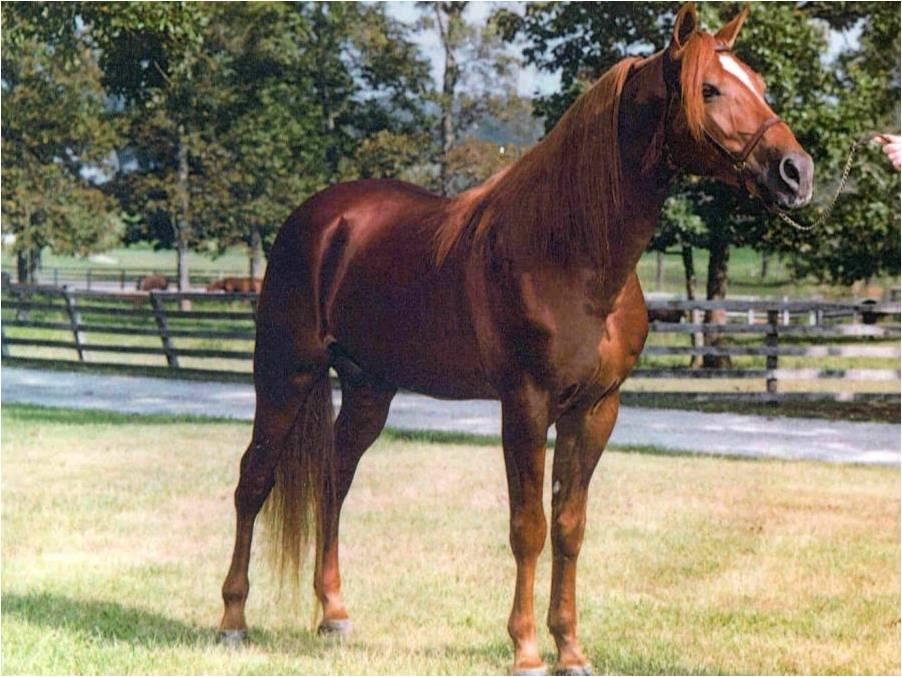
- Type: Light Breed
- Origin: Ozark Mountains, Missouri
- Uses: Team penning, showing, ranch work, trail riding, handicapped ridding programs
- Important Traits: Known for its rhythmic diagonal gait called the fox trot
- Size: 14- 16 Hands
- Color Pattern: Colors include bay, black, roan, brown, buckskin, chestnut, gray, palomino, sorrel, white, cremello, perlino, or champagne. Patterns may be either solid or spotted. White marking on their face and lower legs are common.
The fox trot is an easy, rhythmic diagonal smooth gait with alternating three-hoof, two-hoof support and a reaching step in from rather than high action. This gait allows the horse to be sure-footed in any terrain. The Missouri Fox Trotting Horse is known for its comfort to the rider, making it very popular for trail ridding, competition ridding, or pleasure ridding. This horse was developed in the Ozark Mountains to work on the farm and to be a buggy or riding horse for the family. When many of their jobs were replaced with tractors and cars, the Missouri Fox Trotter continued to remain popular with cattlemen as working ranch horses. Today these horses are used by the U.S. Forest Service because of their dependability and comfort on the trail. Missouri Fox Trotting Horses are found in nearly all states, and Canada, Germany, Austria, Switzerland, and France.
The Missouri Fox Trotting Horse has a straight profile with a proportional face. Ears are well-shaped and pointed and eyes are light and bright. The neck is medium sized and proportioned to the body. The Missouri Fox Trotting Horse has pronounced withers, a short and straight back, a muscular, round croup and a high set tail. The shoulders are muscular and sloped and the chest is deep and broad. The legs are sturdy, muscular, and have good tendons and joints. Hooves are proportional and well formed. The hair should be silky and smooth.

- Type: Light Breed
- Origin: Eastern Kentucky
- Uses: Trail and Pleasure ridding, showing
- Important Traits: Sure-footed, easy gait
- Size: than 14.2 Hands
- Color Pattern: Any solid color including bay, black, roan, gray, buckskin, palomino, chocolate, chestnut, and sorrel. Spotted horses are not encouraged.
The Mountain Pleasure Horse has worked the mountains in Eastern Kentucky for more than 160 years. For years they were called ‘Mountain Horses’ or ‘Country Saddle.’ This horse was bred to work the steep hill sides and to be ridden on the rough terrain. The Mountain Pleasure Horse is born with an evenly spaced, four beat lateral gait. These horses are easy to teach and have a good memory so they are able to show from an early age. Mountain Pleasure horses are one of the many gaited breeds that can be registered with the Kentucky Mountain Pleasure Horse Breed Association. Many people confuse the Rocky Mountain Horse with the Mountain Pleasure Horse. The Mountain Pleasure Horse was used in developing the Rocky Mountain Horse and the Tennessee Walking Horse.
The Mountain Pleasure Horse is a medium size horse with a face that is not protruding or dished. Eyes are bold and ears are well shaped. The neck is proportional to the body, with a graceful arch , and set at an angle to allow natural carriage. The chest is deep and wide and the shoulders are sloping. There are no color restrictions in the Mountain Pleasure Horse Association but the horse cannot be spotted.
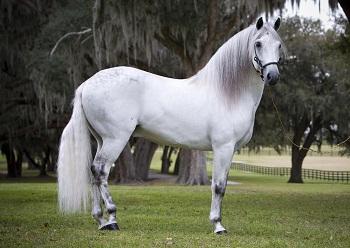

- Type: Light Breed
- Origin: Puerto Rico
- Uses: Showing, Pleasure Riding
- Important Traits: Unique, short-strided, four-beat gait, gentle in hand but show great spirit under saddle
- Size: 14-15 Hands
- Color Pattern: Horses can be any solid or spotted color. Appaloosa patterns are excluded.
The Paso Fino Horse is the result of years of selective breeding in the Caribbean and Latin America. The horse spread to Puerto Rico and Colombia where it became popular. Its name comes for the Spanish phrase “Los Cavallos de Paso Fino” meaning the horses with the fine walk. The Paso Fino is born with a smooth, four-beat gait where the rider appears virtually motionless in the saddle at any speed. The Paso Fino as we know it today was imported to the US after World War II. These horses are known for their brio, which means fire, because they are gentle in hand but have great spirit under saddle. Paso Finos continue to grow in popularity today as pleasure and show horses.
The Paso Fino is a small- to medium-sized horse. They have a slightly convex profile and a small head with eyes that are wide spaces and flared and wide nostrils. The neck is well arched and the withers are not extremely pronounced but definite. The chest is wide and the shoulders are deep through the heart and oblique. The back of the horse can be either short or long. The legs appear delicate with strong tendons. Hooves do not have excess heel and are small.
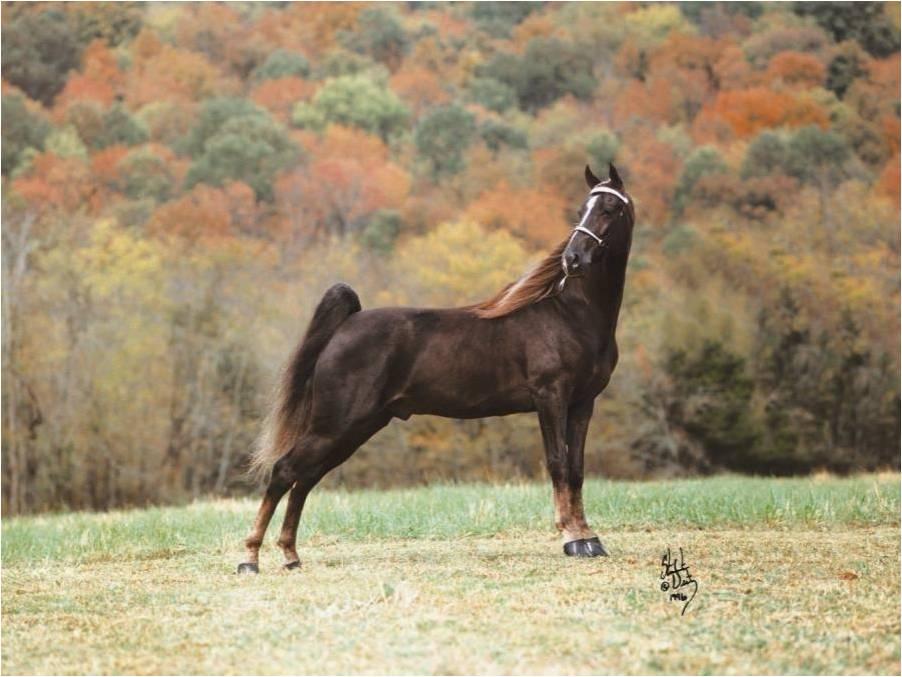
- Type: Light Breed
- Origin: Tennessee
- Uses: Showing, Trail and Pleasure riding
- Important Traits: Intelligence, naturally smooth gaited, nodding their head at the running walk
- Size: 14.3 to 17 Hands
- Color Pattern: Come in all colors and patterns.
In 1885, a Morgan mare and a Standardbred stallion were bred, resulting in Black Allen, the first Tennessee Walking Horse. The breed began to develop in the early 1900’s. The studbook was closed in 1947 and all Tennessee Walkers have had to been born from two Tennessee Walker parent since that point. The Tennessee Walker is known for its natural running walk, that has incredible smoothness. They have a longer bottom line than top allowing them to have a longer stride. Tennessee Walking Horses can be found all over the U.S. although they are most popular in the South.
The Tennessee Walking Horse has a small head with well placed ears. The neck is long and the shoulder is long and sloping. The short back has strong coupling and long sloping hips. The bottom line is longer than the top line, allowing for a long stride. Many Tennessee Walking Horses that are used for performance are shown with double or triple nailed pads which add dimension to the hoof, change certain angles and paths in the hoof’s motion, and provides a sounder base. These pads accent the gaits of show horses. If the horse is used for pleasure ridding, they will not have special shoes.
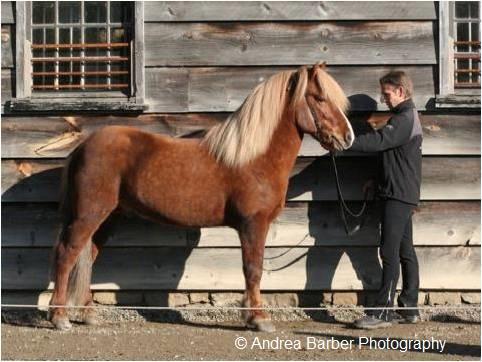
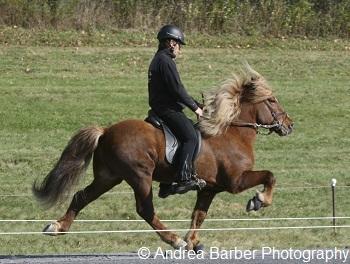
- Type: Light Breed
- Origin: Iceland
- Uses: Pleasure riding, Endurance
- Important Traits: Known for fast and smooth gait, the tölt, lack of spookiness, and sturdy.
- Size: 13 to 14 Hands
- Color Pattern: Any color or pattern. The most common colors include chestnut, brown, bay, and black. The most rare colors are roan and the wind dapples. The coats change with the season although they always have abundant mane and tail. In the winter the coats are very dense. In the summer they are sleek.
The Vikings brought the first horses to Iceland from Norway and the British Isles. Around 1100 AD, it became illegal to import horses into Iceland so the breed remained pure. The Icelandic Horse was the main source of transportation in Iceland until the 1870’s when the first roads were built. The first horses were exported to Germany in the 1940’s. There are about 2,000 Icelandic Horses in the U.S. Using Icelandic Horses for long distance trekking is popular among tourists and Icelanders along with horse shows, races, trading, and pleasure riding. Icelandic horses have a unique gait. They are naturally five-gated, performing the walk, trot, canter, pace and tölt. The tölt is the Icelandic work for rack, a lateral four-beat gait. This breed is the only one with one set of competition rules, has a single standard, and one set of registry rules in all countries in which it is a resident.
The overall shape of the Icelandic horse should be well proportioned and rectangular. The straight profile should include an expressive and clean cut head. The neck and shoulders are long. Icelandic horses have a flexible back with muscular, wide croup. The legs have well-defined joints and have strong, hard hooves. In the winter, they have very heavy, dense coats. Their coats are sleek in the summer although their mane and tail are always abundant.
Ponies

- Type: Pony, Light Breed
- Origin: Iowa
- Uses: Competition mount and pleasure ridding, especially for children and young adults
- Important Traits: Rugged and Athletic, colored with Appaloosa patterns, jumping ability
- Size: 11.5 to 14 Hands
- Color Pattern: Blanket and Leopard patterns are common. Many pony’s are roan. Any irregular edges on patches, similar to a paint or pinto, are prohibited. The horse must have mottled skin somewhere on its body, have visible white sclera, and striped hooves.
The first Pony of the Americas was a cross between an Arab/Appaloosa mare and a Shetland stallion. The colt was born in the 1950’s with white hair and the appearance of black paint smears covering its body. The owner, Les Boomhower, was so fond of the pony that he decided to start a new breed. The first registry had very strict standard on height, coloring, muscular toning and head shape. One of the restrictions was that the pony must look like an Appaloosa from 40 feet away. Some restrictions, such as height, have changed over time but the horses are still used for children to ride and show.
The Pony of the Americas is a medium-sized pony with large eyes and a slightly dished profile. The neck is slightly arched but proportionate to the body. The chest is wide and deep and with withers are prominent. The back is straight and short, the shoulders are sloped and the croup is muscular and round. The legs are solid, strong, and muscular with sloping pasterns and strong tendons. Hooves have vertical or dark stripes and are broad and high at the heel.
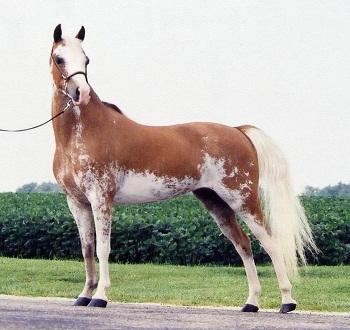
- Type: Pony, Light Breed
- Origin: Shetland Islands, Great Britain
- Uses: Pet, Child Mount, driving small vehicles
- Important Traits: Hard and Strong, Gentle, Versatile
- Size: 10.2 Hands or less
- Color Pattern: Any color except Appaloosa. No particular coat or eye color is preferred. The most popular colors are black and dark brown. May come in silver dapple.
Shetland ponies roamed the hills of the Shetland Islands, with the harsh conditions shaping their breed. They learned to conserve body heat, along with growing a dense coat, heavy mane and tail. The Shetland Pony was first imported to the U.S. in the 1800’s. They were bred to pull ore carts in coal mines until World War II. They are still known for this driving ability. Today there are different types of Shetland Pony’s, the classic and the modern. The classic is known for its style and substance. The modern is strong and attractive, similar to the original Shetland.
The U.S. has separate breed standard for each type of Shetland pony. The Classic Shetland pony has a short head with large nostrils, a wide forehead, sharp, small ears, a fine muzzle, and bright eyes. The neck is proportional with the shape of the body and the shoulders are sloping. The body is sturdy with substance in the hindquarter and chest. The tail sets high on the croup. Legs are well defined and muscular. The Modern Shetland pony is strong and blends the classic pony with quality and refinement. The neck is well arched and the head is carried high. The body’s structure is strong with sloping shoulders, high withers, sturdy feet, and springy pasterns.

- Type: Light Breed
- Origin: Austria and Italy
- Uses: Pleasure and trail ridings, dressage, driving, eventing, jumping, farm work.
- Important Traits: Sturdy and Small Horses, Attractive
- Size: 13- 15 Hands
- Color Pattern: Always chestnut, ranging from rich gold to chocolate. White markings on the face and white on lower legs are common. Mane and tail range from flaxen to white.
Haflingers were developed near the Southern Tyrolean Mountains as farm horses. The first documentation of the modern day Haflinger was 1874 when a half-Arabian stallion was crossed with a Tyrolean mare. There was a shift in breeding practices during World War II to develop a packing horse that was shorter and stockier. Today breeding focuses on developing a small horse that can be used for riding and driving. The Haflinger is unique because of its chestnut coloring and a long, full, white main and tail. The Haflinger is known as a people-loving horse that works well with families. They are used for work and competitions along with therapeutic riding programs. The Haflinger can be found across the US although there is a concentration of them in Ohio and surrounding states.
The Haflinger features a small, well proportioned head with looks similar to an Arabian horse. The large eyes are positioned forward and the nostrils are wide and large. Shoulders are sloped, large, and well muscular. The Haflinger has a deep, broad chest, withers that are pronounced and run far into the back, a muscular, medium length back, and a slightly sloping, long croup. Legs on a Haflinger are well formed with clearly defined joints.

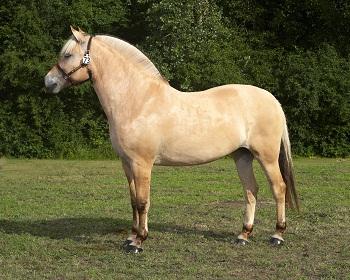
- Type: Light Breed
- Origin: Norway
- Uses: Harness, Saddle, Pleasure
- Important Traits: Endurance, comfortable gaits, easily trained
- Size: 13.2 to 14.2 Hands
- Color Pattern: 90% of Norwegian Fjords are brown dun, the remaining 10% are red, gray, pale gold, or yellow dun. They always have a dorsal stripe running from the forelock down the neck through the middle of the mane, across the back and into the tail. Norwegian Fjord’s have zebra markings on their legs and may also have dark stripes over their withers.
Norwegian Fjord is one of the oldest and purest breeds in the world. They migrated to Norway and were domesticated about 4000 years ago. They were work horses in western Europe, often plowing land or doing other work on farms. The breed has remained pure since the end of the 1800’s. The horses are slightly larger now but are still hardy, with the ability to withstand lower winter temperatures. Twenty-one Norwegian Fjord horses were brought to the US during the 1950’s and they have been increasingly popular since then. The highest concentrations of Norwegian Fjord’s in the US are located in Minnesota and Wisconsin.
The Norwegian Fjord has a medium sized head with a flat, broad forehead and a slightly dished, or straight faced. Ears are alert and small, nostrils are open and flared, and the eyes are large. The neck is short and muscular. The body is short with developed muscles and well-sprung ribs. Shoulders are laid back and muscular and the withers are low, flat, and also muscular. The legs are powerful and short with strong joints and defined tendons. The fetlocks are lightly feathered and the hooves are black and well shaped. The outer hair of the mane is white while the center hair is dark, usually black. The mane is typically cut short so it stands, showing the curve of the neck.
Mules, Donkeys and Wild Horses

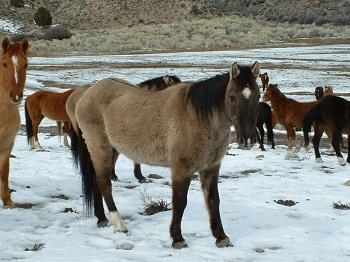
- Type: Light Horse, different breeds
- Origin: Great Plains, North America
- Important Traits: Tough, Adaptability
- Size: 13.2 to 15 Hands
- Color Pattern: Any variety
Horses were first brought to North America by explorers and by 1541 there were an estimated 600 horses. Soon after, Francisco de Ibarra took both horses and cattle to areas in Mexico where they set up a city. After several years the settlers were run out by Indians. A settler returned years later to find more than 10,000 animals roaming freely. This was the beginning of the wild horse.
A bill prohibiting the use of motorized vehicles when hunting burros and wild horses on public land was introduced by a Nevada Congressman in January in 1959. This bill became known as the “Wild Horse Annie Act.” Citizens still saw a need for management, protection and control of the wild horses. The Wild Free-Roaming Horses and Burros Act was introduced in 1971 and amended by the Federal Land Policy and Management Act in 1976 and the Public Rangelands Improvement Act in 1978. These 1976 act allowed Secretaries of the Interior and Agriculture to manage wild horses and burros on public lands by using motorized vehicles and helicopters. The 1978 act established and reaffirmed the need for identification of public rangeland conditions, the continuance of protecting will horses and borrows from branding, harassment, capture or death while still facilitating the removal and disposal of wild horses and borrows who pose a threat to themselves, others or the habitat. Finally, the act allows a transfer of title to an individual who has adopted a removed wild horse or borrow if the animal has received proper treatment from the person for one year. The Bureau of Land Management currently monitors Wild Horses.

- Origin: Africa
- Uses: Packing and Pulling
- Important Traits: Strong and hardy, highly intelligent
- Size: Range from Miniature (under 38 inches) to 16 Hands
- Color Pattern: Gray to brown is normal but they can be any basic horse color. Have dorsal stripes, shoulder crosses.
Donkeys probably originated in Africa and were one of the first commodities that moved to Egypt. There they worked as pack animals while the first pyramids were constructed. Donkeys were first brought to the U.S. by Christopher Columbus as pack animals and to be ridden during the expeditions. Today donkeys are used as companion animals, to guard herds, as pack animals, and as breeding stock to produce mules. Breeds are obscure in the US so donkeys are categorized into four size categories. Miniatures are less than 36 inches at adulthood. The Standard donkey is 36 to 48 inches in height and typically called a burro. The Large Standard Donkey is 48 to 54 inches for females and up to 56 inches for males. The Mammoth is higher than 54 inches for females and higher than 56 inches for males. Donkeys have sixty two chromosomes. When a jenny (a female donkey) is crossed with a stallion, the foal is a hinny and is nearly always infernal.
A donkey has a long head with large eyes and extremely long ears. The neck is straight and short and the withers are nearly flat. The sparse mane is without forelock and upright. The tail is similar to a cows with few long hairs. Donkeys will normally have five lumbar vertebrae, one less that a horse. Donkeys have a narrow chest and are flat-sided. The proportions of a donkey are different than those of a horse. Overall, the body of a donkey is more angular, especially over the hips, than a horses body.

- Origin: Middle East
- Uses: Riding, pack, or draft animal, showing
- Important Traits: Nearly always sterile, good night vision, extremely strong
- Size: Varies depending on parents
- Color Pattern: Any color, based on the traits from either parent
The mule is an equid hybrid resulting from the cross of a jack (male donkey) and a mare. This cross combines qualities of both animals making it intelligent and hardy. Many people mistake the mule as stubborn because it will not put itself in danger. Most mules have ears that are shorter than donkeys but many of their other features are similar. Mules were used in every American war until the Korean. During World War II they were used to travel where most vehicles could not go. Shows for mules are popular across the U.S. where the animals participate in different types of events, including jumping.
As expected, a mule has traits from both horses and donkeys. Mules are classified using three characteristics: use, size, and appearance. Miniature or pony mules are 40 to 48 inches tall at the withers. Saddle mules are 54 inches or more and round-barreled enough to carry a saddle and rider. Pack mules weight around 1000 pounds and are sturdy and short. Work mule are the new classification for farm mule. This type of mule weights 900 to 1300 pounds and are used for pulling wagons and equipment. Draft mules are the final category. They weight 1200 to 1600 pounds and are at least 60 inches tall.
Draft Horses

- Type: Draft Breed
- Origin: Belgium
- Uses: Horse pulls, workhorse
- Important Traits: Power, high stepping action, flaxen mane and tail
- Size: 16 to 18 Hands
- Color Pattern: Normally chestnut, roan, or sorrel with four white stockings, white mane and tail, and a blaze.
Belgians were bred by farmers to be strong, powerful workhorses. The black color became less common and the feathering on their legs were reduced. To entice breeders during the mid 1800’s, the government paid awards to the best stallions and mares. Those who did not win were dropped from breeding programs. Around this same time, Belgians were imported to the U.S. During World War I, Belgian importations from Europe stopped and a new horse began to develop in America. The American Belgian is taller and normally chestnut or sorrel. The Belgian is the most popular draft breed in the U.S.
Today’s American Belgian has some different characteristics than the European Belgian including longer legs and a longer, leaner neck. The profile of the America Belgian is slightly concave or straight. The ears are small, the back is broad and short and the croup is massive, rounded and muscular. The long legs are strong and lean with large a well shaped feet. Overall the body is deep and short

- Type: Draft Breed
- Origin: Scotland
- Uses: Multi-horse hitches and pulling
- Important Traits: Powerful, active, intelligent, feathered legs
- Size: 16 to 18 Hands
- Color Pattern: Bay, Black, and Brown are the most common but can also be roan, gray and chestnut. Nearly always white markings on face, feet, and legs. Some white spots on lower belly.
During the 1700’s these strong horses were used to pack coal. In the early 1800’s breeders began to keep written records. They were used in the Army during World War I but their population declined soon after when mechanical agriculture equipment became popular. In the United Kingdom today there are about seven hundred registered broodmares and about one hundred registered stallions. Clydesdales were in the U.S. in the late 1800’s and has since gone through considerable change ion type, height, and weight. They were thought to be the smaller of the draft horses. Today they are taller and larger than most other horses making them popular at shows and in parades.
The head of the Clydesdale features a broad forehead, big ears, a wide muzzle and a flat profile. The neck is long and arched and the withers are high. The back is strong and short and the quarters are muscular and long. The hind legs should be close together with the point of the points of the hocks turned inward. The shape and quality of the feet are important in Clydesdale horses. The feet should be open, springy, and wide with no hardness.
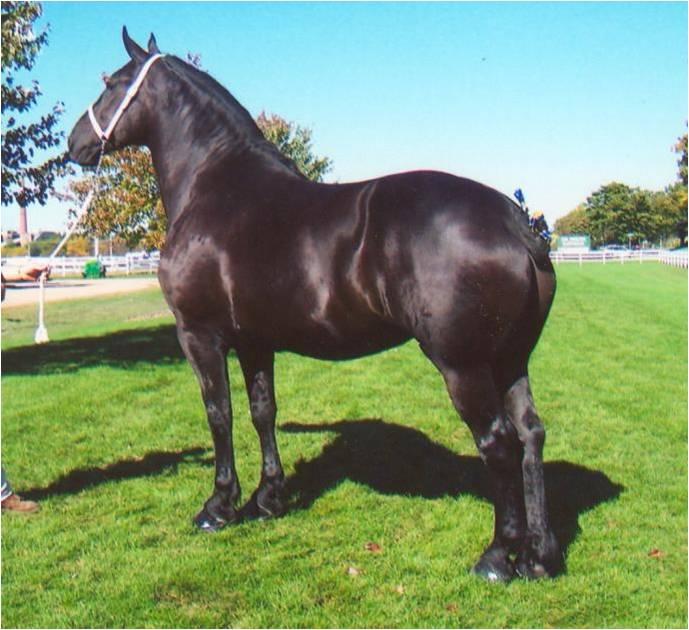
- Type: Draft Breed
- Origin: France
- Uses: Workhorse, harness and carriage
- Important Traits: Elegant, Substance, Soundness
- Size: 15 to 18 Hands
- Color Pattern: Predominately black and gray, also bay, sorrel, and brown. Minimal white markings
Percheron’s were originally ridding horses during war time in France. In times of peace, they were used for farm work, which resulted in the horse being bred for size and strength. They were first brought to the U.S. in 1839. They were the most popular draft horse until mechanical agriculture equipment was developed, when all draft horse numbers declined. Few farmers, including Amish, kept this horse from extinction. Today these horses can be found pulling carriages and participating in sleigh rides, parades, shows, and hay rides.
The Percheron horse has a medium-size head which is broad between the eyes. The neck is curved and the chest is deep and wide. The back is strong, broad, and straight, the croup is level and long, and the hindquarters are muscular. The knees should be well defined and the points of the hock should turn in slightly. The feet are deep and wide at the heel and round and large overall with a good frog.

- Type: Draft Breed
- Origin: England
- Uses: Workhorse, pulling carriages or wagons
- Important Traits: Tallest of draft breeds and one of the heaviest
- Size: 16.2 to 19 Hands
- Color Pattern: Usually bay, brown, black or gray with feathering on legs
The Shire has many ancestors including workhorses and warhorses. When the cavalry began to use smaller horses, the Shire started to develop. The first Shires were called English Cart Horses, known for their power and hair on their knees and upper lip. They were imported to American during the 1800’s for farm work. Today they are commonly crossed with Thoroughbreds to produce hunters of jumpers. They can still be found doing farm work, as well as pulling carriages, logging, and showing.
The head of a Shire is long and lean with a slightly Roman nose, prominent eyes, sensitive ears and a broad forehead. The neck is long, muscular, and slightly arched. The shoulders are deeply sloping and the chest is well muscled and broad. The back is strong and short with a sloping croup. The quarters are long and muscular, the cannons are short and the front legs have broad joints. The legs have long silky feathering below the hocks and knees. The feet are large, somewhat deep and wide at the heels.
Miniature
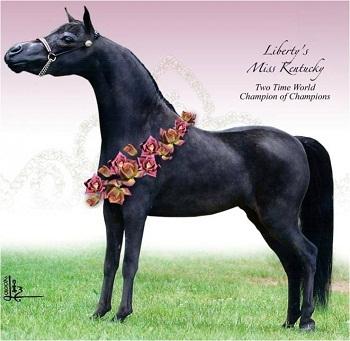
- Type: Light Breed
- Origin: Developed in the US, original stock probably from England
- Uses: Companion animals, showing, driving, and competition
- Important Traits: Intelligence, strength, athleticism
- Size: Maximum of 34 to 38 inches at maturity, depending on association standards.
- Color Pattern: Any color or patterns are accepted
Small Horses have been known as royal pets as far back as the 1600’s. The Miniature Horse came to the US in the late 1800’s. They were used in coal mines in Ohio, Kentucky, Illinois, and Indiana until the 1950’s because of their ability to fit under the low ceilings. Miniatures are the only breed that measure the height of the horse at the last hair of the mane rather than at the highest point of the withers. Miniatures can only be ridden by small children but they do participate in driving, halter, obstacle, and jumping classes. They make great companion animals for children, the elderly, and can even be trained as assistance animals for the blind. The proportions of a Miniature should be the same of a full size horse. Florida, Texas, and California have the most Miniature horses but they can be found in all states and around the world.
There are 2 types of miniature horses, the stock type and the arabian type. Miniature Horses are small, well-balanced with the impressions of symmetry, alertness, strength, and agility. The head includes wide set eyes, large nostrils, medium size, pointed ears and a short distance between the eyes and muzzle. The profile should be slightly concave or straight. The neck should blend into the withers and be in proportion to the body. The shoulder should be sloped and long with muscular forearms. The back should be short with deep girth and flank. The highest point of the croup should be the same height as the withers. The hooves should be compact and round.
Color Registries

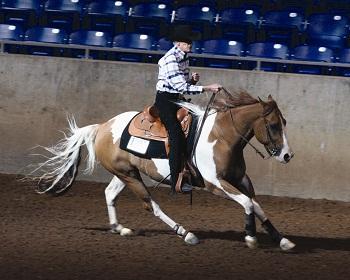


- Type: Color Breed: Stock type, Pleasure type, Miniature type (A & B), Saddle type, Gypsy/Vanner type, Drum type and Hunter type.
- Coat Color: Spotted coat, base coat is white with black, brown, or red spots
- Mane and Tail: Vary
- Skin: Vary
- Markings: Face and leg markings vary.
Patterns similar to the Pinto have existed for thousands of years, as found in early cave paintings. It is unknown when the first pinto patterns arrived in Europe. Some believe it was with the importation of Arabian horses, during the days of the Roman Empire, or from the horses of the Roman steppes. Pintos arrived in the U.S. with the Spanish in search of fortune. Today Pintos can be found anywhere and in any riding discipline. Some of the more common patterns of pinto include tobiano, overo, frame overo, and splash overo. Tobiano horses have a solid colored head, commonly with a marking. The legs are white below the hock and knees, and have dark colors on one of both flanks. Spots are typically oval or round patterns that cover the neck and chest and pass the dorsal midline. Overo horses have at least one leg that is colored, with a bald or bonnet face. Body markings are scattered and irregular with rarely any white extending across the back between the withers and the tail. Frame Overo is the same as the overo but the pattern resembles a frame with the color surrounding the white markings. The splash overo is also an overo variation which has white spots that make the horse appear as if it was dipped in white paint from the group up.
There are many types of Pinto Horses. The Hunter type horse is predominantly Thoroughbred and approved European Warmblood that is suitable for a variety of events such as Hunter Seat and Western. The Stock type horse is a western horse that is predominantly Paint and Quarter horse and is suitable for Western, Hunter Seat and other events. The Pleasure type horse is predominantly Andalusian, Morgan and Arabian breeding and can be used in Western, Hunter and Saddle Seat, Driving, and other events. The Saddle type horse displays high head carriage and animated, high action. They are predominantly from Saddle, Andalusian, Tennessee Walking Horse, or Hackney breeding. They are used in events such as Western, Saddle and Hunter Seat, and Driving. Miniature Horses can also be Pinto. They must meet all registration requirements for Pintos.

Body color near that of an untarnished, US gold coin. Mane and tail are to be flaxen or white. White markings are permitted on the legs, as high as the knee and hock area, and on the face. Animals may not show either draft or pony characteristics. The palomino should stand between 14.2 and 17 hands tall when fully grown and weigh about 1,000 lbs. Breed registries accepted: American Saddlebred, Tennessee Walking Horse, American Morgan Horse, International Arabian Horse, and American Quarter Horse.
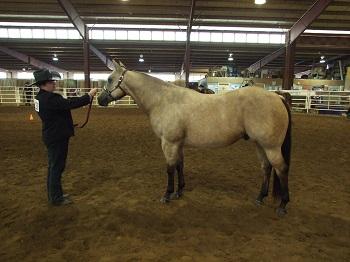
The modern buckskin, as a color breed, is a descendant from ancient time. In the West, horses of the Buckskin, Dun, Red Dun and Grulla shades of colors trace to the Mustang - Spanish Barb descendants which originated in Spain as the Sorraia. Other Buckskins brought to this country can be traced to the Norwegian Dun. Buckskins can be found in all light (not draft) breed types. Eligible colors allowed to register with the American Buckskin Registry Association are buckskin, dun, red dun and grulla.

Once you have read through the Breeds section on our Horse Discovery page, you can test your knowledge here. The quiz will provide automatic grading and reveal the correct answers for learning purposes.
Take the Breeds Knowledge Check here.
Did you score an 80% or higher? Congratulations! Email anna.draeger@uky.edu with a screenshot of your score to receive your celebratory Certificate of Completion for the Breeds section.
